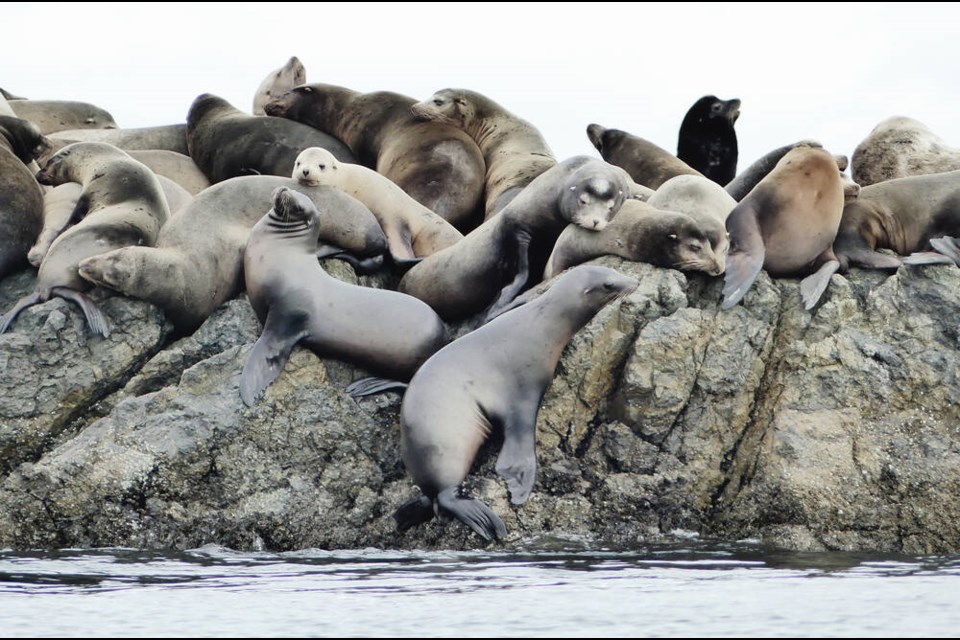The locals are calling it the Sea Lion Symphony.
Every morning since early December, hundreds of California sea lions, Steller sea lions and harbour seals have been hauling out at Trial Islands off Oak Bay and letting loose with a cacophony of growls and barking.
The clatter carries throughout Oak Bay, waking people in the pre-dawn hours. The sound is even audible up the Lansdowne slope and around Mount Tolmie and beyond, before morning traffic hits the roads.
Biologist Jacques Sirois, a volunteer warden at the Trial Islands Ecological Preserve, counted 150 California sea lions, five Steller sea lions and 300 harbour seals on a kayak trip around the rocky shores late last month.
“We haven’t seen anything like this for over 25 years,” said Sirois. “The last time sea lions were waking people up in the morning was 1997. Since then, we’ve had four or five sea lions here, but nothing like this.”
He said it’s the first time he’s visited Trial Islands when mammals outnumber the birds, “so that’s pretty amazing.”
A healthy population of herring is what’s causing the crowd of pinnipeds to stick around, said Sirois.
Department of Fisheries and Oceans officials agree.
Research scientist Strahan Tucker said herring are a chief food source for sea lions and seals and a plentiful supply will keep them around certain areas for long periods.
He said California sea lions are especially vocal with their barks. Most of those at Trial Islands are males, which migrate north from Oregon and California to feed around Vancouver Island.
Steller sea lion bulls can weigh up to 1,500 kilograms, said Tucker, while the California sea lions average about 400 kilograms.
Hundreds of pinnipeds are also gathering and hauling out at Race Rocks, off Metchosin. They will eventually leave, said Tucker.
The emergence of an abundance of herring around Greater Victoria is encouraging, said Sirois.
He said large amounts of herring have all but disappeared from Greater Victoria waters over the past few decades. Fishermen used to line the Craigflower Bridge as the fish swam through the Gorge Waterway, and large balls of herring were common off the waterfront.
“I think it’s safe to say we only have about 10% of the herring we used to have,” said Sirois. “Now there are signs that we do have herring in the area again.”
Sirois said the sea-lion gatherings and massive flocks of gulls are telltale signs the area might be seeing another herring spawn in March that’s similar to or better than the spawn a year ago.
The 2022 spawn off the Fisgard Lighthouse and the south end of Esquimalt Lagoon was the best in more than a decade, he said.
Sirois said flocks of “tens of thousands” of gulls have been spotted in the Otter Point area recently, and there are big flocks around Victoria’s outer harbour and breakwater. Such large numbers, he said, are usually seen in the Hornby Island and Denman Island area, where there is a herring fishery.
The recent sighting of a horned puffin — not usually seen in these parts — feeding at Ogden Point with about 50 rhinoceros auklet sea birds is also a sign of a healthy population of herring, said Sirois.
Sirois has seen herring balls at Ogden Point this winter with fish up to 20 centimetres long — much larger than the usual 12- to 15-centimetre length.
“So we’re waiting to see what happens this year with the herring,” said Sirois, who called Pacific herring a “foundation species” on coastal British Columbia, saying their diminishing numbers are a concern.
Birds, larger fish, otters, seals and about 400 humpback whales that populate the Salish Sea over the year feed on herring, its juvenile species and eggs, Sirois said. He said millions of the fish used to be in Victoria’s harbour, Gorge Waterway and Portage Inlet, but due to overfishing, fewer herring are seen here now.
>>> To comment on this article, write a letter to the editor: [email protected]



